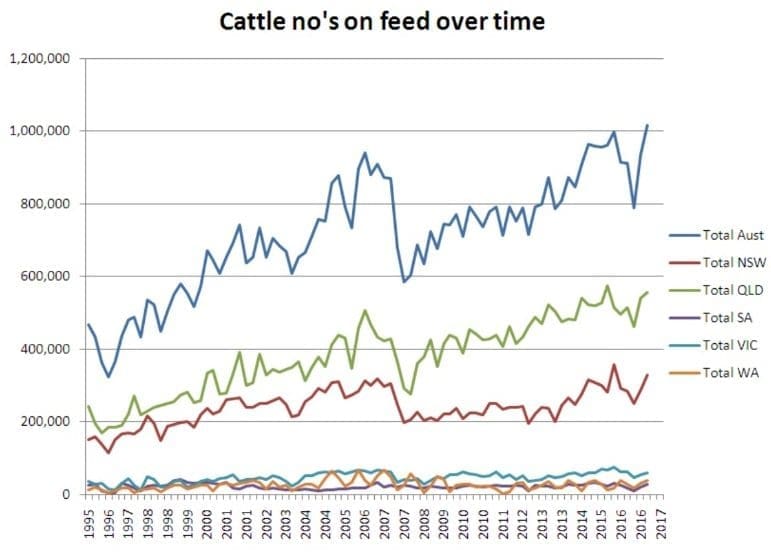CATTLE in grainfed programs across Australia increased 80,687 head, or 8.6pc to an all-time record high at the end of March, according to the results of the quarterly Australian Lot Feeders Association/MLA survey released earlier this evening.
Numbers on feed Australia-wide rose to 1,016,475 head, reflecting an increase in all feeding states. The number topped the previous record of just short of one million head recorded in December 2015, at the height of the drought event.
The March result is more than 100,000 head higher than the same time last year.
Numbers surged 14pc or 43,000 head in NSW in the March quarter to +329,000 head, while Queensland rose 3pc or 16,000 head to almost 557,000 head, the second highest on record. South Australia indicated the biggest percentage increase of 37pc, or 8117 head, followed by Western Australia with a lift of 21pc, or 7233 head. Victoria rose 7000 head to just over 60,000 head on feed.

Feedlot capacity – no longer measured through less reliable sampling methodology, but using actual National Feedlot Accreditation Scheme registration data – showed industry capacity continuing to grow, reaching almost 1.24 million head in March.

ALFA president Tess Herbert
ALFA president Tess Herbert said the results from the March survey reflected the fact that some feedlots are retaining cattle for longer, adding more weight to cattle, and capitalising on the lower cost of grain.
“With tighter cattle supply caused by herd rebuilding activities, cattle are being held on feed for longer periods which has seen the total cattle on feed tick over the one million head mark this quarter,” she said.
“Lotfeeders are also capitalising on lower grain prices, which continue to partially offset higher cattle prices, and are anticipated to remain low on the back of high domestic and global grain supplies,” Ms Herbert said.
She said the growing numbers of cattle on feed, and underlying capacity investment, continued to demonstrate the confidence in the grainfed system.
“We’re seeing the evidence of something that we have known for some time – that lotfeeding is not just a drought mitigation tool, but an integral part of the beef supply chain, ensuring consistent quantity and quality of beef for brand owners and their consumers.”

MLA’s manager of market information, Ben Thomas, said cattle prices had eased slightly from the December Quarter, however the strong competition from restockers had seen cattle prices maintain their historically high levels.
“The quarterly average for the domestic paddock feeder steer indicator averaged 346.69¢/kg, up 11pc from year ago levels,” Mr Thomas said. “The national saleyard feeder steer indicator remained unchanged compared to December quarter figures and also from year ago levels – averaging 337.15¢/kg.”
Despite edging higher than the December quarter, ex-Darling Downs grain prices remained well below year-ago levels through the March quarter. Wheat prices were 10pc lower at $236/t, while barley prices declined 12pc to $211/t, Mr Thomas said.
Riverina wheat prices also eased 29pc year-on-year, to $190/t for the quarter, while barley declined 31pc to $161/t.
Source: MLA/ALFA.
